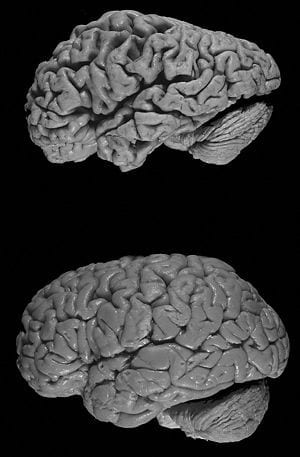
Imagine a pharmaceutical prevention, treatment or even cure for Alzheimer’s disease.
It is almost impossible to overstate how monumental a development that would be and how it would answer the prayers of millions.
Though science isn’t there yet, a new study published in The Journal of Neuroscience spearheaded by USC Davis School of Gerontology researchers offers a tantalizing glimpse of potential solutions.
“Our data suggests the possibility of drugs that can prevent and treat Alzheimer’s,” said lead author, professor and lab principal Christian Pike of USC Davis. “It’s just mouse data but extremely encouraging mouse data.”
The team studied the effects of a class of drugs called TSPO ligands on male mice that were genetically engineered to develop Alzheimer’s disease, known as 3xTg-AD mice. Because a key mechanism of TSPO ligands is to increase production of steroid hormones, it was important to ensure that the mice had low levels of testosterone and related hormones before treatment. Younger mice were castrated while, in older mice, the decrease occurred as a normal consequence of aging.
“We looked at the effects of TSPO ligands in young adult mice when pathology was at an early stage and in aged mice when pathology was quite severe,” Pike said. “TSPO ligands reduced measures of pathology and improved behavior at both ages.”
The most surprising finding for Pike and his team was the effect of TSPO ligands in the aged mice. Four treatments — one per week over four weeks — in aged 3xTg-AD mice resulted in significant lowering of Alzheimer’s-related pathology and improvements in memory behavior. This finding suggested the possibility that TSPO ligands can reverse components of Alzheimer’s and thus have the potential to be useful in treatment.
For humans, these findings may indeed be quite significant.
“TSPO ligands are currently used in humans in certain types of neuroimaging. Newer TSPO ligands are at the clinical trials stage of development for treatment of anxiety and other conditions,” Pike said. “There is a strong possibility that TSPO ligands similar to the ones used in our study could be evaluated for therapeutic efficacy in Alzheimer’s patients within the next few years.”
In light of the findings, the team will next focus on understanding how TSPO ligands reduce Alzheimer’s pathology. Building on the established knowledge that TSPO ligands can act protectively by reducing inflammation, shielding nerve cells from injury and increasing the production of neuroactive hormones in the brain, the team will study which of these actions is the most significant in fighting Alzheimer’s so it can develop newer TSPO ligands accordingly.
While Pike and his team acknowledged that the findings represent an exciting possibility, the researchers also stressed that it is by no means a given.
“From the optimistic perspective, our data provide very promising findings with tangible potential benefits for both the prevention and treatment of Alzheimer’s,” Pike said. “On the pessimistic side, research scientists have developed many interventions that cured Alzheimer’s in mice but have failed to show significant benefits in humans. A critical direction we are currently pursuing is successfully translating these findings into humans.”
The Latest Bing News on:
Alzheimer’s
- Former FOX31 anchor raising awareness after Alzheimer’s claims her mother’s lifeon May 8, 2024 at 9:02 pm
She spent more than a decade at the FOX31 anchor desk, sharing the stories of Coloradans often struggling through difficult times. But Libby Weaver never expected the struggles her own family would face.
- Five ways to celebrate Mother’s Day with someone who has Alzheimer’son May 8, 2024 at 9:30 am
According to the National Institutes of Health, women account for two-thirds of of all Americans living with Alzheimer’s disease. Because of how many women are touched by this disease, the Alzheimer’s Foundation of America (AFA) has come up with some special ways to spend Mother’s Day with the women you love.
The Latest Google Headlines on:
Alzheimer’s
[google_news title=”” keyword=”Alzheimer’s” num_posts=”10″ blurb_length=”0″ show_thumb=”left”]
The Latest Bing News on:
TSPO ligands
- CCR7 and its ligands: balancing immunity and toleranceon April 23, 2024 at 5:00 pm
The chemokines CC-chemokine ligand 19 (CCL19) and CCL21 are ligands for the CC-chemokine receptor 7 (CCR7). CCR7 is expressed by B cells, mature dendritic cells (DCs) and by several T-cell sub ...
- Class II cytokine receptors and their ligands: Key antiviral and inflammatory modulatorson April 23, 2024 at 5:00 pm
The ligands have a common structure with six α-helices, organized as monomers or homodimers, and have 20–30% amino-acid identity. Receptors associate as heterodimers including common chains and ...
- Immune-mediated Liver Diseases: Programmed Cell Death Ligands and Circulating Apoptotic Markerson April 13, 2024 at 5:00 pm
New diagnostic tests can detect these apoptotic markers and programmed cell death ligands such as Fas and Fas-ligands, nucleosomes, caspases, cytokeratin fragments, macrophage migration inhibitory ...
- TSPO, Hey Smith, Catbite and Kill Lincoln to play Japan showson August 28, 2023 at 6:01 am
Tokyo ska Paradie Orchestra, Hey Smith, Catbite, and Kill Lincoln are playing Japan. The crew has four dates set for late October. You can see the dates below. View this post on Instagram ...
- NKG2 ligands for immune checkpoint modulator researchon August 9, 2021 at 3:42 am
NKG2D acts as an activating receptor. The activation of NKG2D by its ligands — such as MICA, MICB and ULBPs (ULBP1, ULBP2, ULBP3, ULBP4, ULBP5, ULBP6) — in human and H60 (a–c), RAE(α–ε ...
The Latest Google Headlines on:
TSPO ligands
[google_news title=”” keyword=”TSPO ligands” num_posts=”10″ blurb_length=”0″ show_thumb=”left”]











